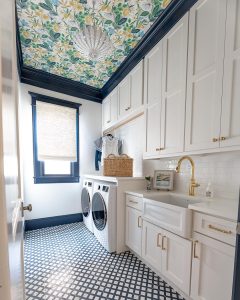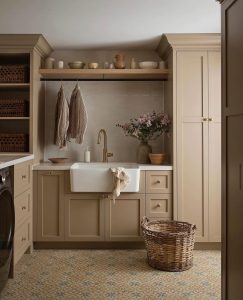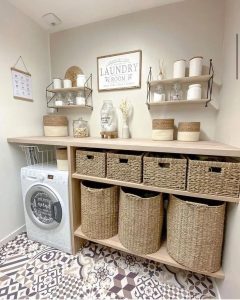Laundry Room Dimensions: How Big Should It Be? It’s a question many of us don’t ask until we’re knee-deep in baskets and detergent.
Whether you’re building from scratch or reworking a tight corner, knowing the right size for a laundry room can make all the difference. It’s not just about fitting appliances. It’s about creating a space that works for your daily rhythms and feels like an extension of your home.
Some laundry rooms are cozy closets. Others stretch out into full-blown utility spaces. There’s no one-size-fits-all. But there is a size that fits your needs best.
This guide will walk you through standard laundry room sizes and how to work with whatever space you’ve got. We’ll talk about must-have clearances, storage ideas, and real-life layouts that feel just right.
Whether your laundry room is a nook off the kitchen or a space all its own, let’s figure out how to make it both useful and lovely. After all, doing the laundry might never be your favorite chore—but your laundry room can still be one of your favorite spaces.
Standard Laundry Room Dimensions Explained
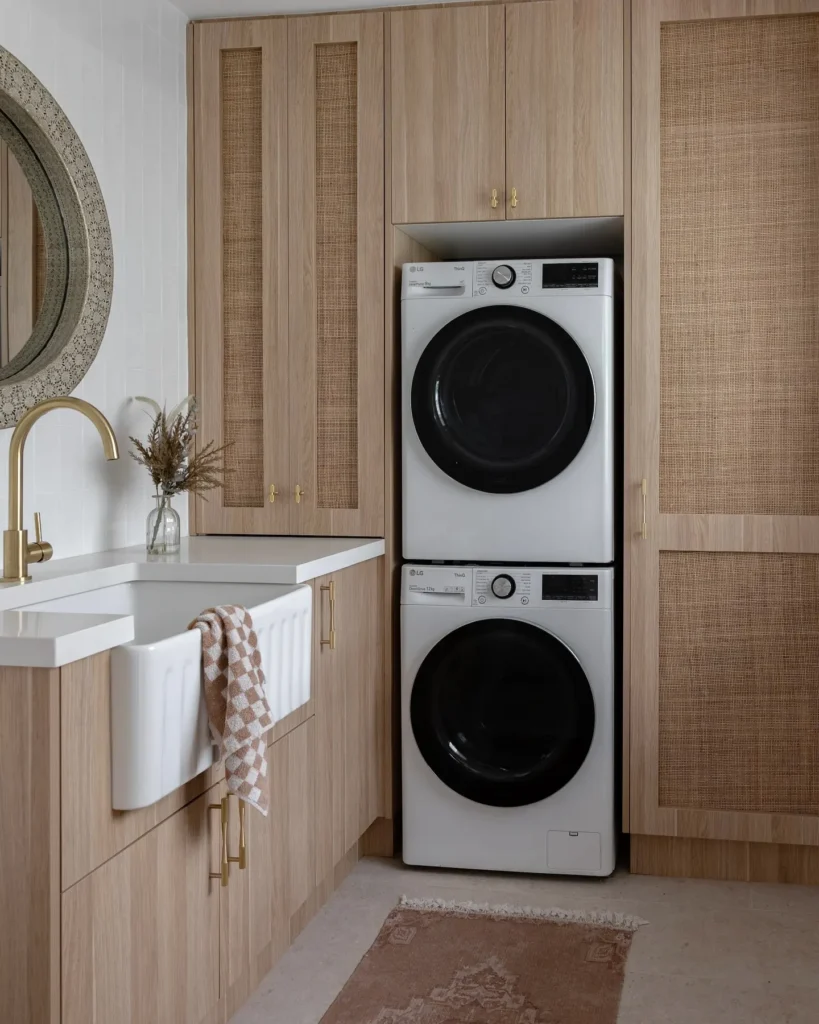
When planning a laundry room, size does matter—but it’s more about smart use than square footage. Whether you’re working with a small nook or planning a spacious setup, understanding the standard dimensions gives you a helpful starting point.
Let’s break it down by room type so you can see what’s realistic and what’s possible.
What Is the Average Size of a Laundry Room?
Most laundry rooms fall between 35 and 120 square feet. That’s a big range, but it all depends on your home layout and what features you want to include.
- Compact laundry closets: 3′ x 3′ to 5′ x 5′
- Standard laundry rooms: 6′ x 7′ to 8′ x 10′
- Spacious utility rooms: 10′ x 10′ and up
Even small spaces can shine with thoughtful planning. Your Ultimate Guide to Designing a Stylish and Functional Laundry Room offers great ideas for turning any size room into something special.
Dimensions for a Small Laundry Room or Closet
For many homes, especially apartments or older builds, the laundry area is more of a closet than a room.
Here’s what you’ll need:
- Stackable washer/dryer: Minimum space of 24″ width x 30″ depth x 72″ height
- Side-by-side units: At least 60″ wide and 30″ deep
- Door clearance: Allow 42–48″ in front of machines for door swing and access
If your machines are front-loading, keep the door clearance in mind. You’ll want to open them without bumping into a wall or cabinet.
Bonus tip: add upper shelves or a hanging rod above your machines for extra function. Pair that with our post on How to Choose a Drying Rack for Your Small Laundry Room for ideas that maximize every inch.
And if you’re starting with a narrow or compact layout, you might also love How to Maximize Space in Your Long Narrow Laundry Room or How To Maximize Small Laundry Room Storage Space. These posts are full of space-saving tricks I’ve come to swear by.
Ideal Dimensions for a Full Laundry Room
If you have the room, a full laundry layout gives you space to move and organize.
Aim for a room that’s at least:
- 6′ wide x 9′ long for side-by-side machines
- 3–4 feet of clear space in front of machines
- Countertops for folding: 24–30″ deep
- Cabinets or tall storage: At least 12–15″ deep
Want a sink? Plan for an extra 30–36″ of width.
This gives you plenty of room for storage, folding, and even a decorative moment or two. To elevate your finishes, check out The Best Materials for Laundry Room Cabinets.
Functional Laundry Room Layouts Based on Dimensions
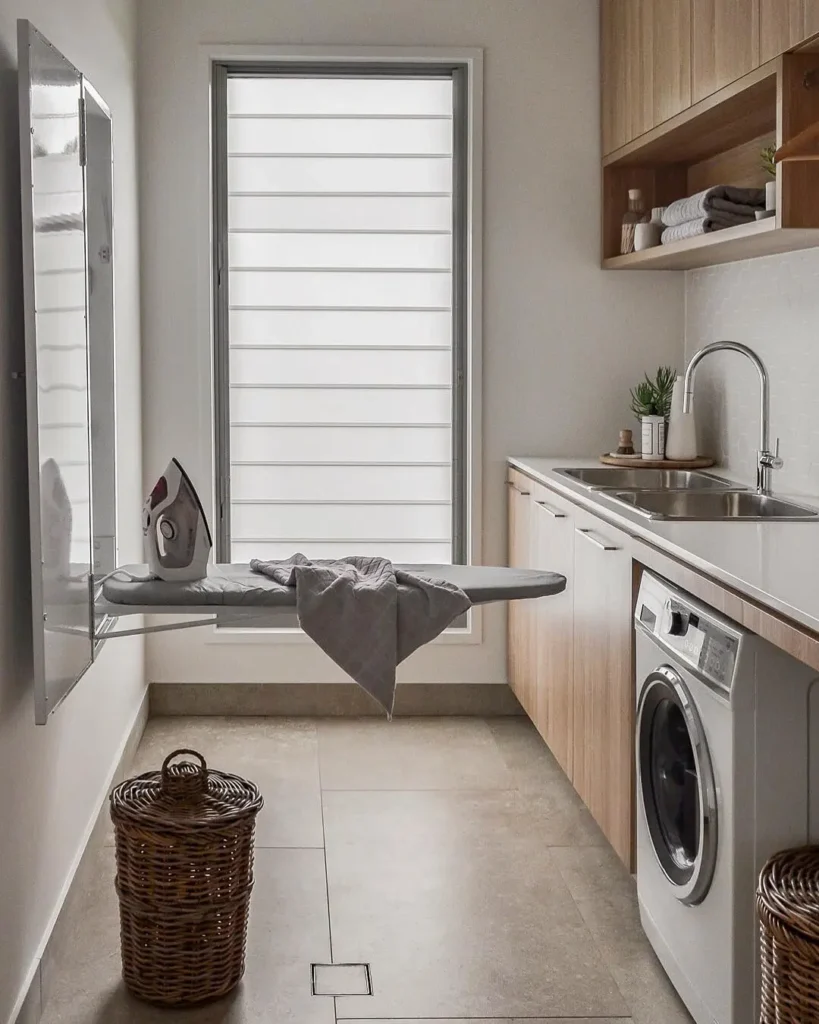
Knowing how big your laundry room should be is one thing. Figuring out how to use that space well? That’s where layout really matters.
Whether you have a long, narrow nook or a wide-open room, your layout sets the tone for how easily laundry gets done—and how much you enjoy the process.
Galley Laundry Rooms
Galley-style layouts are common in narrow spaces. Think of them like hallways with a purpose.
If this is your setup, keep these tips in mind:
- Place machines on one side to free up walking space.
- Leave at least 36 inches between appliances and walls for movement.
- Use vertical storage to keep things neat and tidy.
For more inspiration, How to Maximize Space in Your Long Narrow Laundry Room is packed with real-life examples that show what’s possible in a slim layout.
L-Shaped and U-Shaped Laundry Rooms
These layouts give you room to spread out. They’re great when you want more work zones.
L-shaped rooms fit well in a corner:
- Machines on one wall
- Sink or folding counter on the adjacent wall
U-shaped rooms work best in medium-to-large spaces:
- Machines in the center
- Storage and counters wrapping around the sides
This style allows for folding, sorting, and even seating—if you have the room.
Combined Laundry and Mudrooms
Many homes combine the laundry and mudroom into one. It’s a smart way to make use of shared square footage.
If this is your space:
- Plan for at least 6′ x 10′ to comfortably include laundry and entry functions.
- Use hooks, baskets, and cubbies to keep things organized.
- Separate the laundry zone with a rug or a half wall to define the space.
It helps the room feel purposeful, not chaotic.
This layout works especially well in busy family homes. Bonus: it turns a chore zone into a welcome-home moment.
Must-Have Clearances and Appliance Spacing
A well-planned laundry room doesn’t just look good—it works better. And a big part of that is having the right space around your machines and storage.
You don’t need fancy equipment to make it work. But you do need a few smart measurements to make sure everything fits and functions.
Washer and Dryer Spacing Guidelines
Let’s start with the heart of the laundry room: your washer and dryer.
Here are the basics:
- Side clearance: Leave at least 1″ on each side of the appliance.
- Back clearance: Allow 4–6″ for hoses, cords, and ventilation.
- Front clearance: Plan for 42–48″ in front for loading and door swing.
If you’re going with front-loading machines, make sure doors can open fully. Better yet, leave enough room to open both at once without knocking into cabinets or walls.
And if you’re stacking your units, double-check ceiling height. You’ll need around 80 inches from floor to top of the upper unit.
Check out Everything You Need to Know Before Buying a Stackable Washer and Dryer for more details on vertical setups.
Space for Folding, Hanging, and Sorting
Even in a small laundry room, work zones make life easier. Think of them as mini stations for folding, drying, and organizing.
- Folding counter: 24–30″ deep is ideal.
- Hanging rod: Mount 40–50″ above the floor for shirts and dresses.
- Sorting bins: Try 15″ width each if placing side by side.
If you’re tight on space, mount a fold-down table or wall shelf. It tucks away when not in use.
Need ideas? How To Easily Add a Folding Station to Your Small Laundry Room shares clever ways to carve out folding space, even in the smallest rooms.
Storage and Cabinet Dimensions
Storage makes or breaks a laundry room. The good news? It doesn’t have to be fancy—just functional.
Here are ideal cabinet dimensions:
- Upper cabinets: 12–15″ deep
- Base cabinets: 24″ deep
- Countertops: 36″ high for folding comfort
Add a few baskets or bins for socks, dryer sheets, and lost-and-found items. Label them if you’d like. It’s a small touch that makes a big impact.
If you’re selecting finishes, head over to The Best Materials for Laundry Room Cabinets for durable and stylish options.
Laundry Room Dimensions for Different Home Sizes
No matter the size of your home, there’s always a way to create a laundry space that feels intentional and efficient. Whether you’re working with a hallway closet or a roomy bonus room, what matters most is making it work for you.
Let’s explore what laundry room dimensions look like across a range of home sizes.
Apartments and Condos
In a small apartment or condo, the laundry room is often just a closet—or a corner tucked behind sliding doors.
That’s okay. Small spaces can still be mighty.
Ideal dimensions:
- 3′ x 3′ for a stacked washer/dryer
- 5′ x 5′ for side-by-side units (with tight clearance)
Stackable units are your best friend here. Pair them with wall-mounted shelves or a hanging rod. If you’re looking to save even more space, consider slim, ventless machines.
For stylish inspiration in a compact footprint, visit How to Create a Sleek and Stylish Modern Laundry Room.
Townhomes and Small Homes
These homes usually offer a little more breathing room. Many smaller homes have a compact laundry room or a simple pass-through space.
Recommended size:
- 5′ x 7′ to 6′ x 8′ for a side-by-side setup
- Enough depth (at least 30″) for standard appliances
Add a small folding counter or a utility sink if space allows. Hooks and wall baskets go a long way toward keeping things organized.
Need extra help making it all fit? How To Maximize Small Laundry Room Storage Space has plenty of practical storage solutions.
Larger Homes or Custom Builds
If you’re building from scratch or doing a full remodel, the laundry room becomes a blank canvas.
Ideal dimensions:
- 10′ x 10′ or larger
- Room for multiple work zones: appliances, sink, folding, hanging, storage
This is your chance to create a true utility hub. You might even add a second washer, built-in hampers, or a pet washing station.
Design tip: use mixed materials or fun finishes to give the space personality. How to Create a Modern Farmhouse Laundry Room and The Best Vintage Accents for Your Rustic Farmhouse Laundry Room offer inspiration for both cozy and collected styles.
Expert Tips for Designing Based on Your Laundry Room Dimensions
No matter the size of your laundry room, thoughtful design makes all the difference. A little planning upfront can help you avoid daily frustration later.
Let’s walk through a few tips to help you get the most from your space—whether you’re designing from scratch or reworking what you’ve got.
How to Prioritize Layout Features in Limited Space
Start with the non-negotiables. For most homes, that’s the washer and dryer. Once you know their placement, everything else falls into place.
Here’s what to consider:
- Storage: Choose vertical cabinets if floor space is tight.
- Folding: Add a narrow counter or pull-down shelf.
- Drying: Use a retractable rack or tension rod above the machines.
Small tweaks can create big impact. If you’re short on inspiration, How Can Creative Storage Hacks Transform Your Laundry Area is full of clever solutions you can try today.
Tips for Remodeling or Building New
If you’re starting from scratch, this is your chance to get it right from the beginning.
Here’s what to keep in mind:
- Lighting: Natural light is ideal. Add overhead and task lighting too.
- Plumbing: Place machines close to water lines to cut costs.
- Ventilation: Make sure the space is well-vented to reduce humidity.
Don’t forget to leave breathing room. Overfilling the space makes it feel cramped, even if the room is big on paper.
And if you’re building custom? Talk to your contractor about leaving a bit of extra room in the design. It’s amazing how fast bins, baskets, and bottles fill up a room.
Common Mistakes to Avoid
Even the most beautiful laundry room can fall flat if it’s not functional. Here are a few common design missteps to watch out for:
- Skipping clearances: Don’t push machines against the wall—leave room to connect hoses and cords.
- Ignoring door swings: Check that appliance doors and entry doors don’t block each other.
- Forgetting flow: Place storage where it makes sense—detergents near machines, hampers near the folding area.
And most of all, don’t try to copy someone else’s setup exactly. The best laundry rooms are built around your daily life.
Visualizing the Right Laundry Room Size for You
It’s one thing to read measurements on a screen. It’s another to see how those sizes come to life. This section offers a few layout ideas to help you picture the space you need—and want.
Whether you’re working with a closet or designing a dream space, these examples can guide your plan.
Floor Plan Examples by Size
Let’s look at how laundry rooms work across three common sizes.
1. Compact Closet (5′ x 5′)
- Stackable washer and dryer
- One floating shelf for supplies
- Wall-mounted drying rack
- Curtain or sliding door to hide the space when not in use
This setup is all about essentials. Still, with a few smart choices, it can feel stylish and neat.
2. Standard Laundry Room (6′ x 9′)
- Side-by-side washer and dryer
- Countertop above machines for folding
- Upper cabinets or shelves for storage
- Narrow utility sink on one side
This layout strikes a balance between form and function. It’s a great fit for most homes.
3. Spacious Utility Room (10′ x 10’+)
- Side-by-side or dual machines
- Full-length folding counter
- Deep sink and pull-out hampers
- Wall space for hanging, ironing, or even pet washing
Here, there’s room to add personality. Think wallpaper, statement lighting, or antique storage furniture.
Each layout serves a different lifestyle. The goal is to make your laundry room feel both beautiful and hardworking—no matter its size.
Style Meets Function: Make Every Inch Count
Don’t forget, it’s the small design touches that turn a practical space into one you love.
- Add wallpaper or a fun paint color to brighten things up.
- Swap plain hardware for something vintage or bold.
- Use baskets, jars, or even antique bowls for storing clothespins and supplies.
You can bring your personal style into the laundry room—just like you do in any other part of your home.
Need some style-specific inspiration? Try:
- How to Style a Coastal-Inspired Laundry Room
- How to Create a Moody Laundry Room
- 10 Laundry Room Decor Ideas That Make You Love Doing Laundry
Conclusion
So, Laundry Room Dimensions: How Big Should It Be? The answer is—it depends on your home, your habits, and your hopes for the space.
There’s no perfect size. But there is a right size for you.
Whether you’re working with five square feet or fifty, the key is to design with purpose. Focus on flow, function, and a few meaningful touches that make laundry day feel a little more pleasant.
Remember, your laundry room doesn’t have to be perfect. It just needs to work well and feel like part of the home you love.
If you’re ready to take the next step, explore:
- How to Create a Modern Farmhouse Laundry Room
- 25 Laundry Room Tips That Save Time and Stress
- The Best Vintage Accents For Your Rustic Farmhouse Laundry Room
You’ve got this. And your laundry room is more than a place for chores—it’s another chance to create beauty in the everyday.
Frequently Asked Questions
How much space do I need at minimum for a laundry area?
The smallest functional laundry setup is about 3′ x 3′, enough for a stackable washer and dryer. You’ll also need a few extra inches around the machines for clearance.
Is it possible to create a laundry space in a hallway or closet?
Yes! Hallway and closet laundry setups are common in smaller homes. Just make sure to account for ventilation, door swing, and a bit of space for storage.
How deep should a laundry room be for front-loading machines?
Plan for at least 36–42 inches of depth. This includes the machine, wall clearance, and space for the door to open comfortably.
What’s the ideal laundry room size for a family of four or more?
A 6′ x 9′ or larger room works well for families. This allows space for side-by-side appliances, folding, sorting, and maybe even a sink.
Do I need a permit to change my laundry room layout?
It really comes down to where you live and how big the project is. If your project involves moving plumbing, electrical lines, or structural walls, there’s a good chance you’ll need a permit. Check with your local building office before starting.
Related Posts:
- Small Space Storage Hacks: The Magic of Wire Baskets
- Your Ultimate Functional and Stylish Mudroom Guide

